Insolvency in Australia: Director Responsibilities and ASIC Role
VerifiedAdded on 2019/10/31
|8
|2887
|249
Essay
AI Summary
This essay examines the multifaceted aspects of company insolvency in Australia, with a specific focus on the duties and responsibilities of company directors and the role of the Australian Securities and Investments Commission (ASIC). It defines insolvency, highlighting its signs and processes, including receivership, liquidation, and voluntary administration. The essay emphasizes the directors' duty to prevent insolvent trading, as outlined in the Corporations Act 2001, and their responsibilities to shareholders, creditors, and employees. It discusses the importance of seeking timely legal and accounting advice, exploring options like restructuring and refinancing. The essay also provides insolvency statistics, topical issues, and ASIC's role in guiding directors to prevent insolvent trading. The essay concludes by underscoring the importance of proactive measures and adherence to regulatory guidelines to safeguard companies from insolvency.

Paraphrase This Document
Need a fresh take? Get an instant paraphrase of this document with our AI Paraphraser
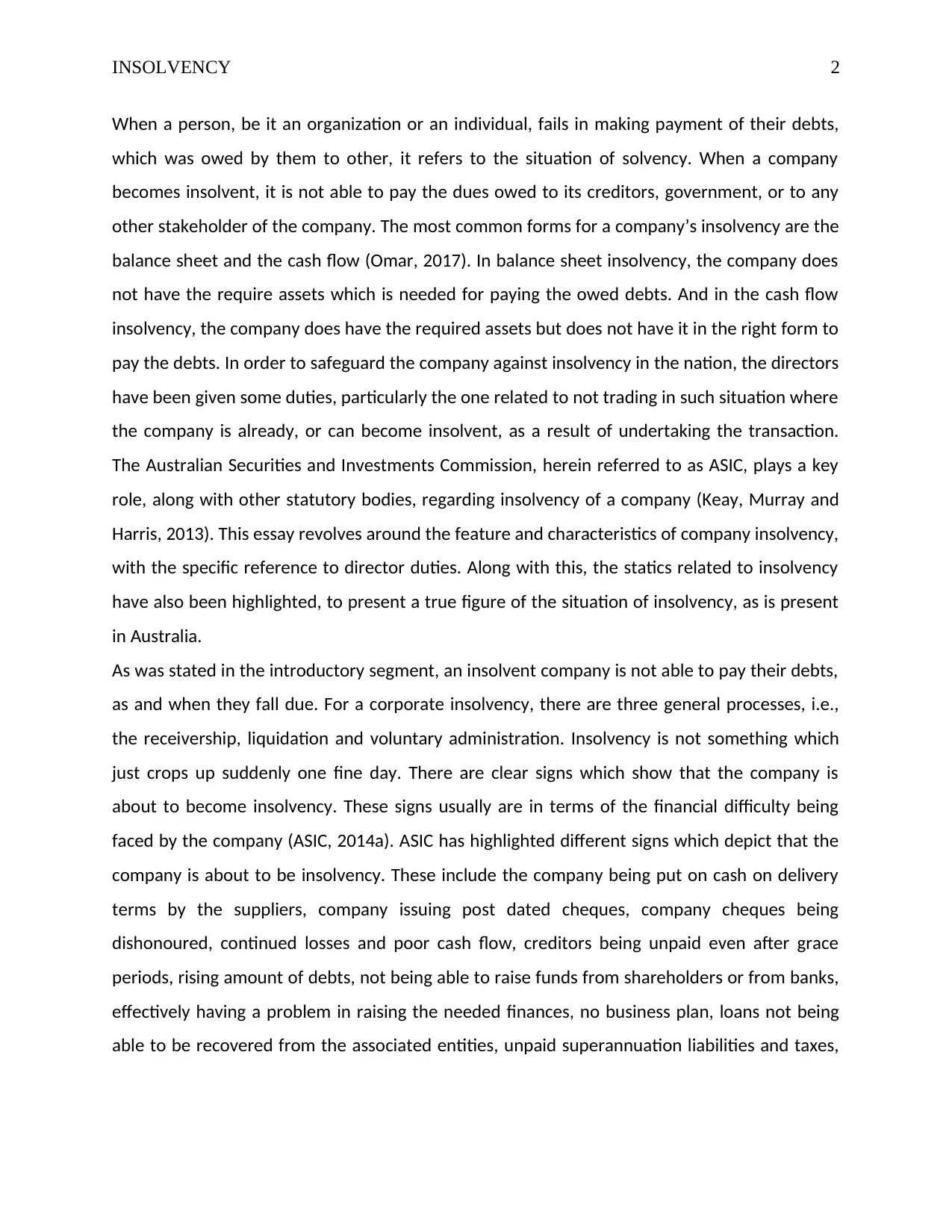
INSOLVENCY 2
When a person, be it an organization or an individual, fails in making payment of their debts,
which was owed by them to other, it refers to the situation of solvency. When a company
becomes insolvent, it is not able to pay the dues owed to its creditors, government, or to any
other stakeholder of the company. The most common forms for a company’s insolvency are the
balance sheet and the cash flow (Omar, 2017). In balance sheet insolvency, the company does
not have the require assets which is needed for paying the owed debts. And in the cash flow
insolvency, the company does have the required assets but does not have it in the right form to
pay the debts. In order to safeguard the company against insolvency in the nation, the directors
have been given some duties, particularly the one related to not trading in such situation where
the company is already, or can become insolvent, as a result of undertaking the transaction.
The Australian Securities and Investments Commission, herein referred to as ASIC, plays a key
role, along with other statutory bodies, regarding insolvency of a company (Keay, Murray and
Harris, 2013). This essay revolves around the feature and characteristics of company insolvency,
with the specific reference to director duties. Along with this, the statics related to insolvency
have also been highlighted, to present a true figure of the situation of insolvency, as is present
in Australia.
As was stated in the introductory segment, an insolvent company is not able to pay their debts,
as and when they fall due. For a corporate insolvency, there are three general processes, i.e.,
the receivership, liquidation and voluntary administration. Insolvency is not something which
just crops up suddenly one fine day. There are clear signs which show that the company is
about to become insolvency. These signs usually are in terms of the financial difficulty being
faced by the company (ASIC, 2014a). ASIC has highlighted different signs which depict that the
company is about to be insolvency. These include the company being put on cash on delivery
terms by the suppliers, company issuing post dated cheques, company cheques being
dishonoured, continued losses and poor cash flow, creditors being unpaid even after grace
periods, rising amount of debts, not being able to raise funds from shareholders or from banks,
effectively having a problem in raising the needed finances, no business plan, loans not being
able to be recovered from the associated entities, unpaid superannuation liabilities and taxes,
When a person, be it an organization or an individual, fails in making payment of their debts,
which was owed by them to other, it refers to the situation of solvency. When a company
becomes insolvent, it is not able to pay the dues owed to its creditors, government, or to any
other stakeholder of the company. The most common forms for a company’s insolvency are the
balance sheet and the cash flow (Omar, 2017). In balance sheet insolvency, the company does
not have the require assets which is needed for paying the owed debts. And in the cash flow
insolvency, the company does have the required assets but does not have it in the right form to
pay the debts. In order to safeguard the company against insolvency in the nation, the directors
have been given some duties, particularly the one related to not trading in such situation where
the company is already, or can become insolvent, as a result of undertaking the transaction.
The Australian Securities and Investments Commission, herein referred to as ASIC, plays a key
role, along with other statutory bodies, regarding insolvency of a company (Keay, Murray and
Harris, 2013). This essay revolves around the feature and characteristics of company insolvency,
with the specific reference to director duties. Along with this, the statics related to insolvency
have also been highlighted, to present a true figure of the situation of insolvency, as is present
in Australia.
As was stated in the introductory segment, an insolvent company is not able to pay their debts,
as and when they fall due. For a corporate insolvency, there are three general processes, i.e.,
the receivership, liquidation and voluntary administration. Insolvency is not something which
just crops up suddenly one fine day. There are clear signs which show that the company is
about to become insolvency. These signs usually are in terms of the financial difficulty being
faced by the company (ASIC, 2014a). ASIC has highlighted different signs which depict that the
company is about to be insolvency. These include the company being put on cash on delivery
terms by the suppliers, company issuing post dated cheques, company cheques being
dishonoured, continued losses and poor cash flow, creditors being unpaid even after grace
periods, rising amount of debts, not being able to raise funds from shareholders or from banks,
effectively having a problem in raising the needed finances, no business plan, loans not being
able to be recovered from the associated entities, unpaid superannuation liabilities and taxes,
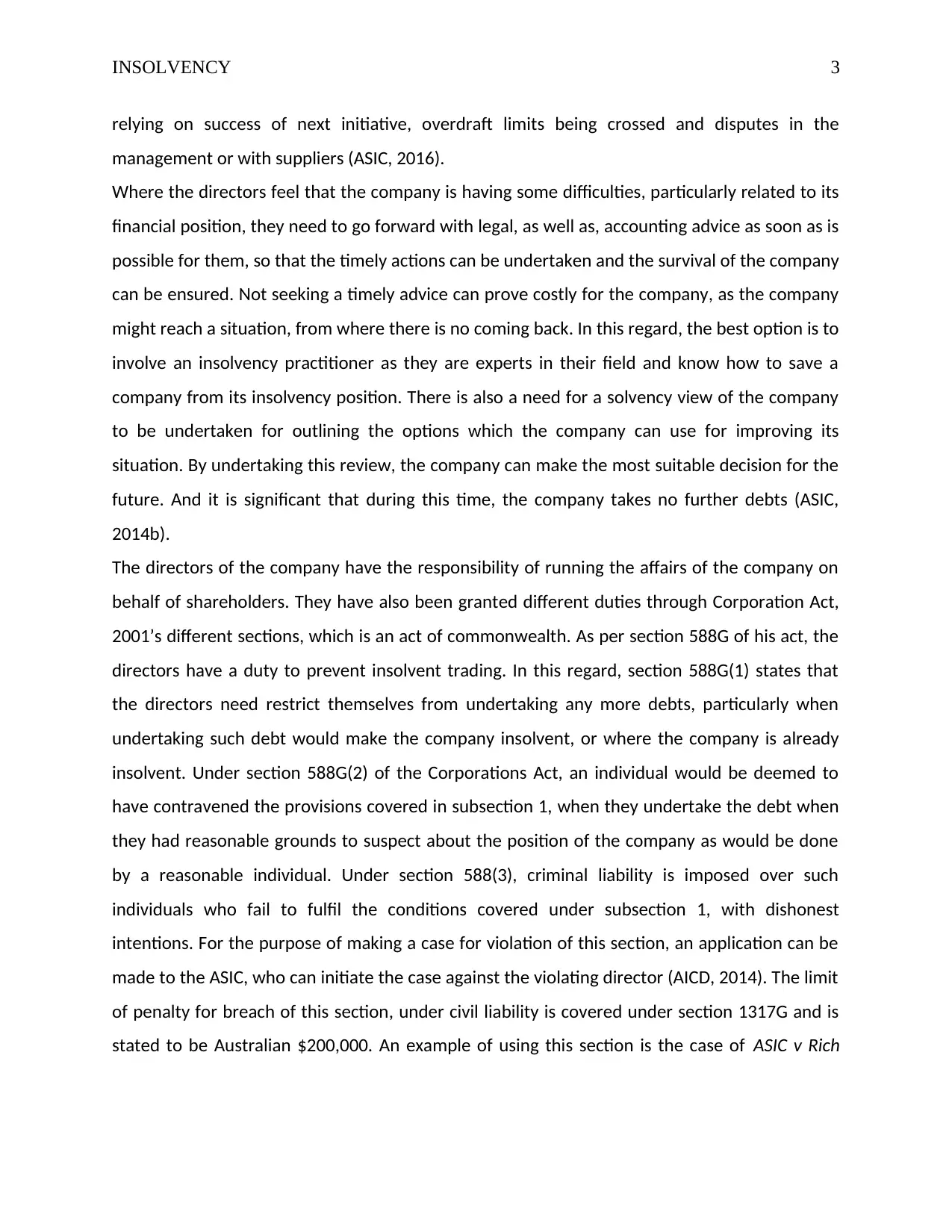
INSOLVENCY 3
relying on success of next initiative, overdraft limits being crossed and disputes in the
management or with suppliers (ASIC, 2016).
Where the directors feel that the company is having some difficulties, particularly related to its
financial position, they need to go forward with legal, as well as, accounting advice as soon as is
possible for them, so that the timely actions can be undertaken and the survival of the company
can be ensured. Not seeking a timely advice can prove costly for the company, as the company
might reach a situation, from where there is no coming back. In this regard, the best option is to
involve an insolvency practitioner as they are experts in their field and know how to save a
company from its insolvency position. There is also a need for a solvency view of the company
to be undertaken for outlining the options which the company can use for improving its
situation. By undertaking this review, the company can make the most suitable decision for the
future. And it is significant that during this time, the company takes no further debts (ASIC,
2014b).
The directors of the company have the responsibility of running the affairs of the company on
behalf of shareholders. They have also been granted different duties through Corporation Act,
2001’s different sections, which is an act of commonwealth. As per section 588G of his act, the
directors have a duty to prevent insolvent trading. In this regard, section 588G(1) states that
the directors need restrict themselves from undertaking any more debts, particularly when
undertaking such debt would make the company insolvent, or where the company is already
insolvent. Under section 588G(2) of the Corporations Act, an individual would be deemed to
have contravened the provisions covered in subsection 1, when they undertake the debt when
they had reasonable grounds to suspect about the position of the company as would be done
by a reasonable individual. Under section 588(3), criminal liability is imposed over such
individuals who fail to fulfil the conditions covered under subsection 1, with dishonest
intentions. For the purpose of making a case for violation of this section, an application can be
made to the ASIC, who can initiate the case against the violating director (AICD, 2014). The limit
of penalty for breach of this section, under civil liability is covered under section 1317G and is
stated to be Australian $200,000. An example of using this section is the case of ASIC v Rich
relying on success of next initiative, overdraft limits being crossed and disputes in the
management or with suppliers (ASIC, 2016).
Where the directors feel that the company is having some difficulties, particularly related to its
financial position, they need to go forward with legal, as well as, accounting advice as soon as is
possible for them, so that the timely actions can be undertaken and the survival of the company
can be ensured. Not seeking a timely advice can prove costly for the company, as the company
might reach a situation, from where there is no coming back. In this regard, the best option is to
involve an insolvency practitioner as they are experts in their field and know how to save a
company from its insolvency position. There is also a need for a solvency view of the company
to be undertaken for outlining the options which the company can use for improving its
situation. By undertaking this review, the company can make the most suitable decision for the
future. And it is significant that during this time, the company takes no further debts (ASIC,
2014b).
The directors of the company have the responsibility of running the affairs of the company on
behalf of shareholders. They have also been granted different duties through Corporation Act,
2001’s different sections, which is an act of commonwealth. As per section 588G of his act, the
directors have a duty to prevent insolvent trading. In this regard, section 588G(1) states that
the directors need restrict themselves from undertaking any more debts, particularly when
undertaking such debt would make the company insolvent, or where the company is already
insolvent. Under section 588G(2) of the Corporations Act, an individual would be deemed to
have contravened the provisions covered in subsection 1, when they undertake the debt when
they had reasonable grounds to suspect about the position of the company as would be done
by a reasonable individual. Under section 588(3), criminal liability is imposed over such
individuals who fail to fulfil the conditions covered under subsection 1, with dishonest
intentions. For the purpose of making a case for violation of this section, an application can be
made to the ASIC, who can initiate the case against the violating director (AICD, 2014). The limit
of penalty for breach of this section, under civil liability is covered under section 1317G and is
stated to be Australian $200,000. An example of using this section is the case of ASIC v Rich
⊘ This is a preview!⊘
Do you want full access?
Subscribe today to unlock all pages.

Trusted by 1+ million students worldwide
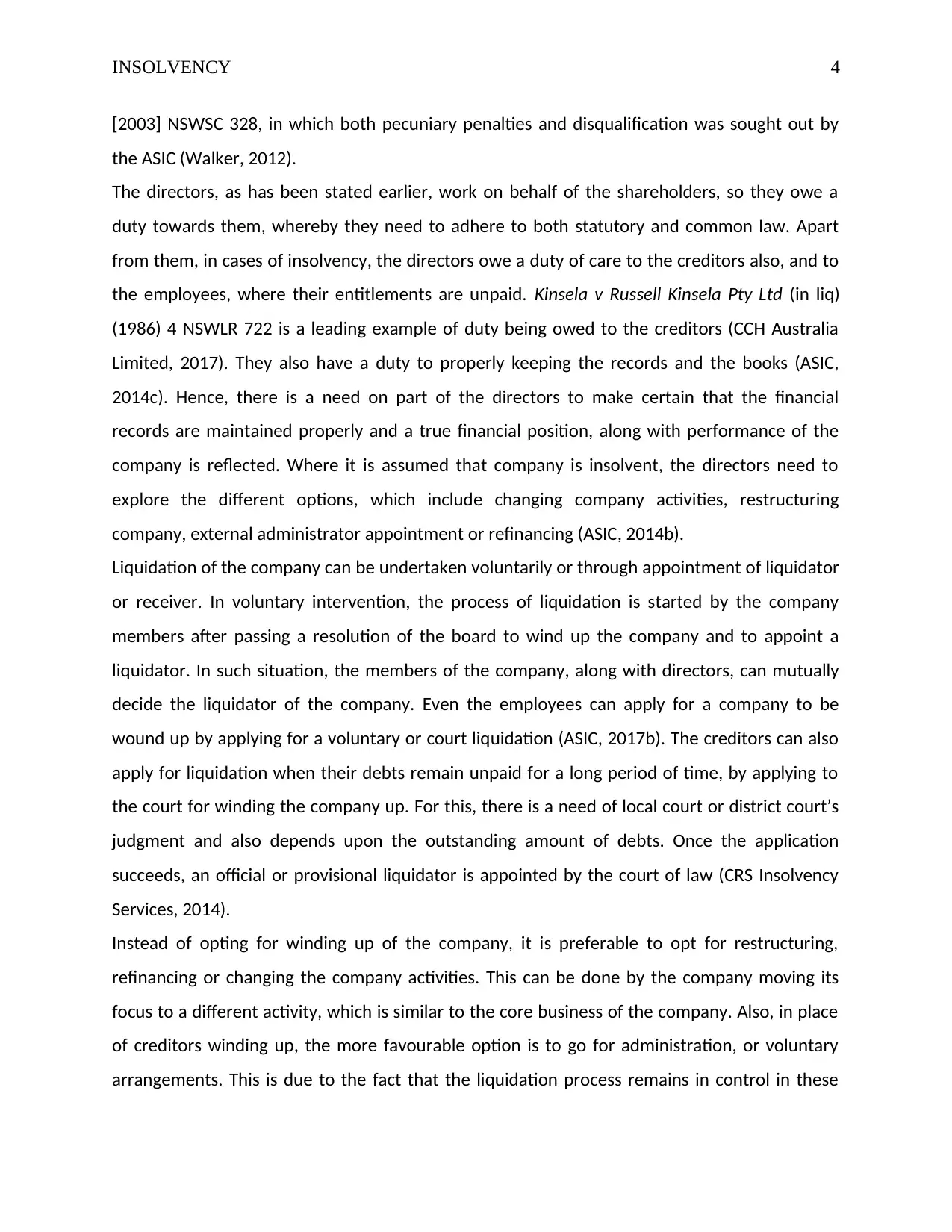
INSOLVENCY 4
[2003] NSWSC 328, in which both pecuniary penalties and disqualification was sought out by
the ASIC (Walker, 2012).
The directors, as has been stated earlier, work on behalf of the shareholders, so they owe a
duty towards them, whereby they need to adhere to both statutory and common law. Apart
from them, in cases of insolvency, the directors owe a duty of care to the creditors also, and to
the employees, where their entitlements are unpaid. Kinsela v Russell Kinsela Pty Ltd (in liq)
(1986) 4 NSWLR 722 is a leading example of duty being owed to the creditors (CCH Australia
Limited, 2017). They also have a duty to properly keeping the records and the books (ASIC,
2014c). Hence, there is a need on part of the directors to make certain that the financial
records are maintained properly and a true financial position, along with performance of the
company is reflected. Where it is assumed that company is insolvent, the directors need to
explore the different options, which include changing company activities, restructuring
company, external administrator appointment or refinancing (ASIC, 2014b).
Liquidation of the company can be undertaken voluntarily or through appointment of liquidator
or receiver. In voluntary intervention, the process of liquidation is started by the company
members after passing a resolution of the board to wind up the company and to appoint a
liquidator. In such situation, the members of the company, along with directors, can mutually
decide the liquidator of the company. Even the employees can apply for a company to be
wound up by applying for a voluntary or court liquidation (ASIC, 2017b). The creditors can also
apply for liquidation when their debts remain unpaid for a long period of time, by applying to
the court for winding the company up. For this, there is a need of local court or district court’s
judgment and also depends upon the outstanding amount of debts. Once the application
succeeds, an official or provisional liquidator is appointed by the court of law (CRS Insolvency
Services, 2014).
Instead of opting for winding up of the company, it is preferable to opt for restructuring,
refinancing or changing the company activities. This can be done by the company moving its
focus to a different activity, which is similar to the core business of the company. Also, in place
of creditors winding up, the more favourable option is to go for administration, or voluntary
arrangements. This is due to the fact that the liquidation process remains in control in these
[2003] NSWSC 328, in which both pecuniary penalties and disqualification was sought out by
the ASIC (Walker, 2012).
The directors, as has been stated earlier, work on behalf of the shareholders, so they owe a
duty towards them, whereby they need to adhere to both statutory and common law. Apart
from them, in cases of insolvency, the directors owe a duty of care to the creditors also, and to
the employees, where their entitlements are unpaid. Kinsela v Russell Kinsela Pty Ltd (in liq)
(1986) 4 NSWLR 722 is a leading example of duty being owed to the creditors (CCH Australia
Limited, 2017). They also have a duty to properly keeping the records and the books (ASIC,
2014c). Hence, there is a need on part of the directors to make certain that the financial
records are maintained properly and a true financial position, along with performance of the
company is reflected. Where it is assumed that company is insolvent, the directors need to
explore the different options, which include changing company activities, restructuring
company, external administrator appointment or refinancing (ASIC, 2014b).
Liquidation of the company can be undertaken voluntarily or through appointment of liquidator
or receiver. In voluntary intervention, the process of liquidation is started by the company
members after passing a resolution of the board to wind up the company and to appoint a
liquidator. In such situation, the members of the company, along with directors, can mutually
decide the liquidator of the company. Even the employees can apply for a company to be
wound up by applying for a voluntary or court liquidation (ASIC, 2017b). The creditors can also
apply for liquidation when their debts remain unpaid for a long period of time, by applying to
the court for winding the company up. For this, there is a need of local court or district court’s
judgment and also depends upon the outstanding amount of debts. Once the application
succeeds, an official or provisional liquidator is appointed by the court of law (CRS Insolvency
Services, 2014).
Instead of opting for winding up of the company, it is preferable to opt for restructuring,
refinancing or changing the company activities. This can be done by the company moving its
focus to a different activity, which is similar to the core business of the company. Also, in place
of creditors winding up, the more favourable option is to go for administration, or voluntary
arrangements. This is due to the fact that the liquidation process remains in control in these
Paraphrase This Document
Need a fresh take? Get an instant paraphrase of this document with our AI Paraphraser
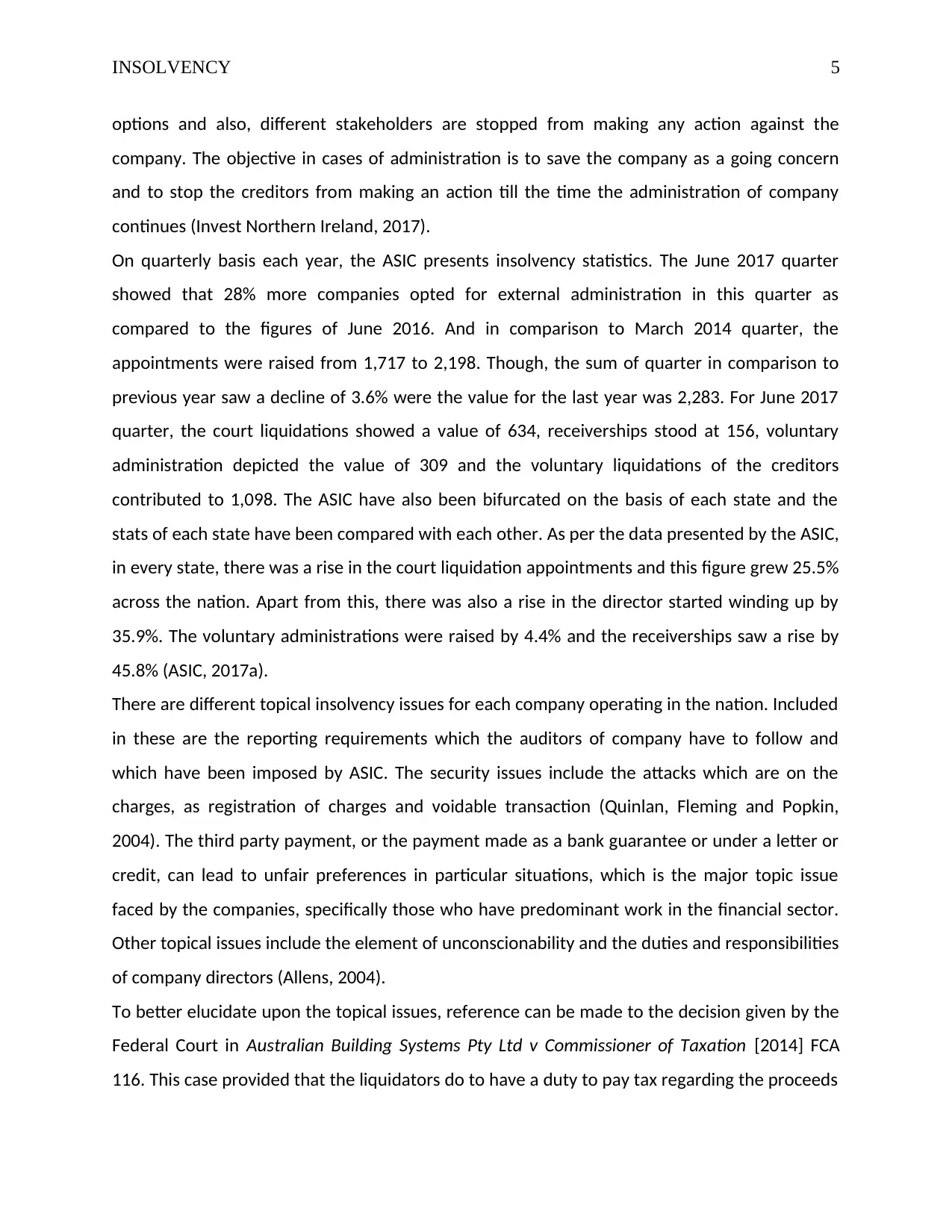
INSOLVENCY 5
options and also, different stakeholders are stopped from making any action against the
company. The objective in cases of administration is to save the company as a going concern
and to stop the creditors from making an action till the time the administration of company
continues (Invest Northern Ireland, 2017).
On quarterly basis each year, the ASIC presents insolvency statistics. The June 2017 quarter
showed that 28% more companies opted for external administration in this quarter as
compared to the figures of June 2016. And in comparison to March 2014 quarter, the
appointments were raised from 1,717 to 2,198. Though, the sum of quarter in comparison to
previous year saw a decline of 3.6% were the value for the last year was 2,283. For June 2017
quarter, the court liquidations showed a value of 634, receiverships stood at 156, voluntary
administration depicted the value of 309 and the voluntary liquidations of the creditors
contributed to 1,098. The ASIC have also been bifurcated on the basis of each state and the
stats of each state have been compared with each other. As per the data presented by the ASIC,
in every state, there was a rise in the court liquidation appointments and this figure grew 25.5%
across the nation. Apart from this, there was also a rise in the director started winding up by
35.9%. The voluntary administrations were raised by 4.4% and the receiverships saw a rise by
45.8% (ASIC, 2017a).
There are different topical insolvency issues for each company operating in the nation. Included
in these are the reporting requirements which the auditors of company have to follow and
which have been imposed by ASIC. The security issues include the attacks which are on the
charges, as registration of charges and voidable transaction (Quinlan, Fleming and Popkin,
2004). The third party payment, or the payment made as a bank guarantee or under a letter or
credit, can lead to unfair preferences in particular situations, which is the major topic issue
faced by the companies, specifically those who have predominant work in the financial sector.
Other topical issues include the element of unconscionability and the duties and responsibilities
of company directors (Allens, 2004).
To better elucidate upon the topical issues, reference can be made to the decision given by the
Federal Court in Australian Building Systems Pty Ltd v Commissioner of Taxation [2014] FCA
116. This case provided that the liquidators do to have a duty to pay tax regarding the proceeds
options and also, different stakeholders are stopped from making any action against the
company. The objective in cases of administration is to save the company as a going concern
and to stop the creditors from making an action till the time the administration of company
continues (Invest Northern Ireland, 2017).
On quarterly basis each year, the ASIC presents insolvency statistics. The June 2017 quarter
showed that 28% more companies opted for external administration in this quarter as
compared to the figures of June 2016. And in comparison to March 2014 quarter, the
appointments were raised from 1,717 to 2,198. Though, the sum of quarter in comparison to
previous year saw a decline of 3.6% were the value for the last year was 2,283. For June 2017
quarter, the court liquidations showed a value of 634, receiverships stood at 156, voluntary
administration depicted the value of 309 and the voluntary liquidations of the creditors
contributed to 1,098. The ASIC have also been bifurcated on the basis of each state and the
stats of each state have been compared with each other. As per the data presented by the ASIC,
in every state, there was a rise in the court liquidation appointments and this figure grew 25.5%
across the nation. Apart from this, there was also a rise in the director started winding up by
35.9%. The voluntary administrations were raised by 4.4% and the receiverships saw a rise by
45.8% (ASIC, 2017a).
There are different topical insolvency issues for each company operating in the nation. Included
in these are the reporting requirements which the auditors of company have to follow and
which have been imposed by ASIC. The security issues include the attacks which are on the
charges, as registration of charges and voidable transaction (Quinlan, Fleming and Popkin,
2004). The third party payment, or the payment made as a bank guarantee or under a letter or
credit, can lead to unfair preferences in particular situations, which is the major topic issue
faced by the companies, specifically those who have predominant work in the financial sector.
Other topical issues include the element of unconscionability and the duties and responsibilities
of company directors (Allens, 2004).
To better elucidate upon the topical issues, reference can be made to the decision given by the
Federal Court in Australian Building Systems Pty Ltd v Commissioner of Taxation [2014] FCA
116. This case provided that the liquidators do to have a duty to pay tax regarding the proceeds
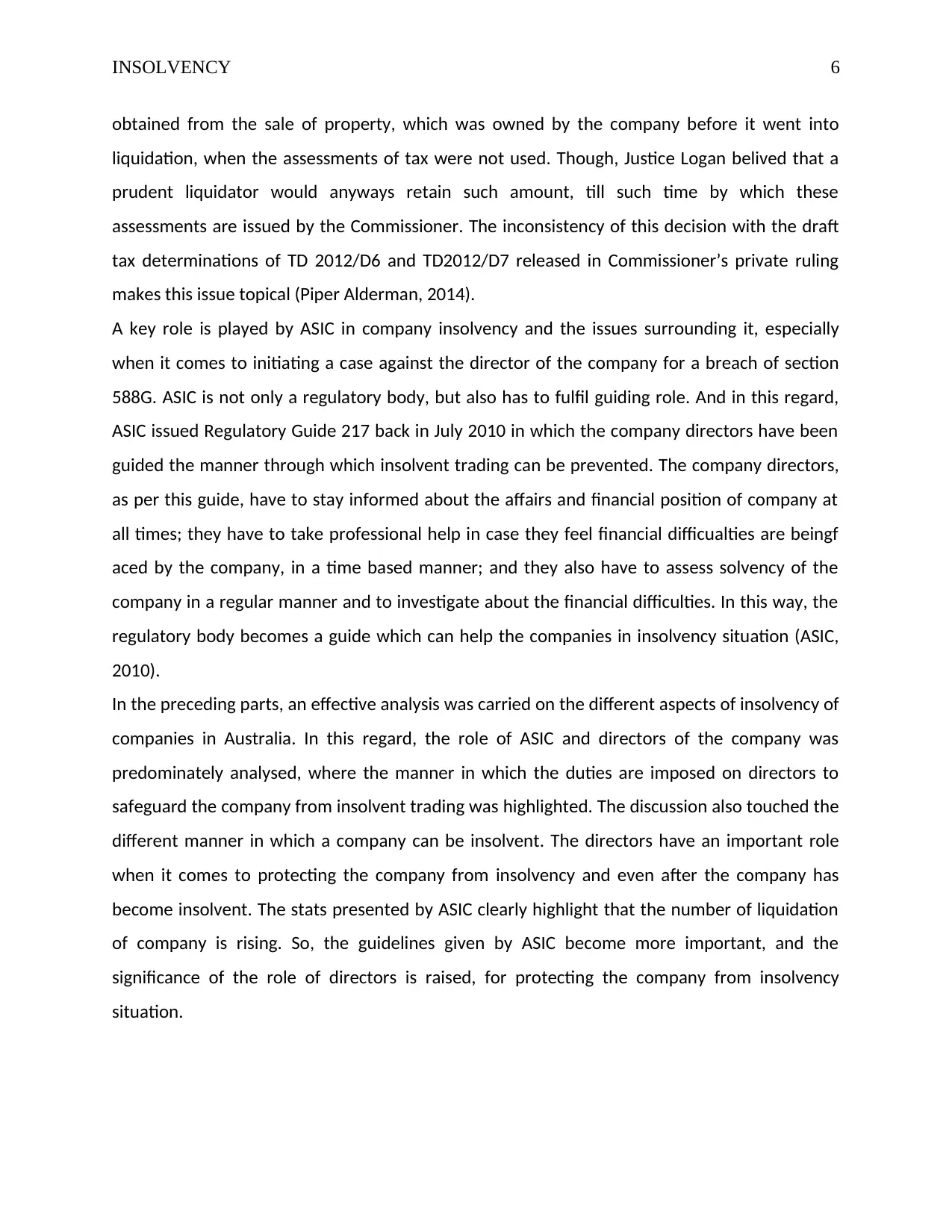
INSOLVENCY 6
obtained from the sale of property, which was owned by the company before it went into
liquidation, when the assessments of tax were not used. Though, Justice Logan belived that a
prudent liquidator would anyways retain such amount, till such time by which these
assessments are issued by the Commissioner. The inconsistency of this decision with the draft
tax determinations of TD 2012/D6 and TD2012/D7 released in Commissioner’s private ruling
makes this issue topical (Piper Alderman, 2014).
A key role is played by ASIC in company insolvency and the issues surrounding it, especially
when it comes to initiating a case against the director of the company for a breach of section
588G. ASIC is not only a regulatory body, but also has to fulfil guiding role. And in this regard,
ASIC issued Regulatory Guide 217 back in July 2010 in which the company directors have been
guided the manner through which insolvent trading can be prevented. The company directors,
as per this guide, have to stay informed about the affairs and financial position of company at
all times; they have to take professional help in case they feel financial difficualties are beingf
aced by the company, in a time based manner; and they also have to assess solvency of the
company in a regular manner and to investigate about the financial difficulties. In this way, the
regulatory body becomes a guide which can help the companies in insolvency situation (ASIC,
2010).
In the preceding parts, an effective analysis was carried on the different aspects of insolvency of
companies in Australia. In this regard, the role of ASIC and directors of the company was
predominately analysed, where the manner in which the duties are imposed on directors to
safeguard the company from insolvent trading was highlighted. The discussion also touched the
different manner in which a company can be insolvent. The directors have an important role
when it comes to protecting the company from insolvency and even after the company has
become insolvent. The stats presented by ASIC clearly highlight that the number of liquidation
of company is rising. So, the guidelines given by ASIC become more important, and the
significance of the role of directors is raised, for protecting the company from insolvency
situation.
obtained from the sale of property, which was owned by the company before it went into
liquidation, when the assessments of tax were not used. Though, Justice Logan belived that a
prudent liquidator would anyways retain such amount, till such time by which these
assessments are issued by the Commissioner. The inconsistency of this decision with the draft
tax determinations of TD 2012/D6 and TD2012/D7 released in Commissioner’s private ruling
makes this issue topical (Piper Alderman, 2014).
A key role is played by ASIC in company insolvency and the issues surrounding it, especially
when it comes to initiating a case against the director of the company for a breach of section
588G. ASIC is not only a regulatory body, but also has to fulfil guiding role. And in this regard,
ASIC issued Regulatory Guide 217 back in July 2010 in which the company directors have been
guided the manner through which insolvent trading can be prevented. The company directors,
as per this guide, have to stay informed about the affairs and financial position of company at
all times; they have to take professional help in case they feel financial difficualties are beingf
aced by the company, in a time based manner; and they also have to assess solvency of the
company in a regular manner and to investigate about the financial difficulties. In this way, the
regulatory body becomes a guide which can help the companies in insolvency situation (ASIC,
2010).
In the preceding parts, an effective analysis was carried on the different aspects of insolvency of
companies in Australia. In this regard, the role of ASIC and directors of the company was
predominately analysed, where the manner in which the duties are imposed on directors to
safeguard the company from insolvent trading was highlighted. The discussion also touched the
different manner in which a company can be insolvent. The directors have an important role
when it comes to protecting the company from insolvency and even after the company has
become insolvent. The stats presented by ASIC clearly highlight that the number of liquidation
of company is rising. So, the guidelines given by ASIC become more important, and the
significance of the role of directors is raised, for protecting the company from insolvency
situation.
⊘ This is a preview!⊘
Do you want full access?
Subscribe today to unlock all pages.

Trusted by 1+ million students worldwide
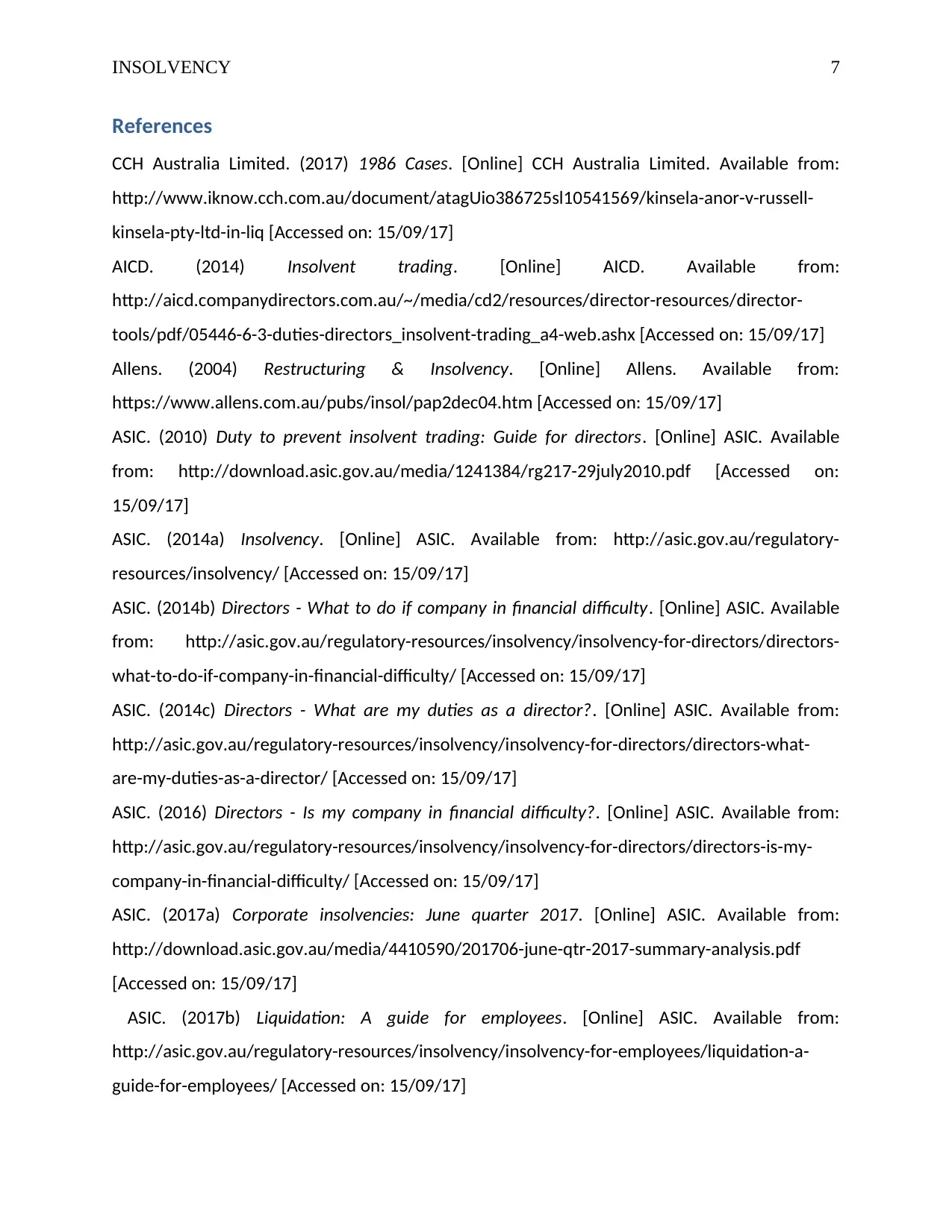
INSOLVENCY 7
References
CCH Australia Limited. (2017) 1986 Cases. [Online] CCH Australia Limited. Available from:
http://www.iknow.cch.com.au/document/atagUio386725sl10541569/kinsela-anor-v-russell-
kinsela-pty-ltd-in-liq [Accessed on: 15/09/17]
AICD. (2014) Insolvent trading. [Online] AICD. Available from:
http://aicd.companydirectors.com.au/~/media/cd2/resources/director-resources/director-
tools/pdf/05446-6-3-duties-directors_insolvent-trading_a4-web.ashx [Accessed on: 15/09/17]
Allens. (2004) Restructuring & Insolvency. [Online] Allens. Available from:
https://www.allens.com.au/pubs/insol/pap2dec04.htm [Accessed on: 15/09/17]
ASIC. (2010) Duty to prevent insolvent trading: Guide for directors. [Online] ASIC. Available
from: http://download.asic.gov.au/media/1241384/rg217-29july2010.pdf [Accessed on:
15/09/17]
ASIC. (2014a) Insolvency. [Online] ASIC. Available from: http://asic.gov.au/regulatory-
resources/insolvency/ [Accessed on: 15/09/17]
ASIC. (2014b) Directors - What to do if company in financial difficulty. [Online] ASIC. Available
from: http://asic.gov.au/regulatory-resources/insolvency/insolvency-for-directors/directors-
what-to-do-if-company-in-financial-difficulty/ [Accessed on: 15/09/17]
ASIC. (2014c) Directors - What are my duties as a director?. [Online] ASIC. Available from:
http://asic.gov.au/regulatory-resources/insolvency/insolvency-for-directors/directors-what-
are-my-duties-as-a-director/ [Accessed on: 15/09/17]
ASIC. (2016) Directors - Is my company in financial difficulty?. [Online] ASIC. Available from:
http://asic.gov.au/regulatory-resources/insolvency/insolvency-for-directors/directors-is-my-
company-in-financial-difficulty/ [Accessed on: 15/09/17]
ASIC. (2017a) Corporate insolvencies: June quarter 2017. [Online] ASIC. Available from:
http://download.asic.gov.au/media/4410590/201706-june-qtr-2017-summary-analysis.pdf
[Accessed on: 15/09/17]
ASIC. (2017b) Liquidation: A guide for employees. [Online] ASIC. Available from:
http://asic.gov.au/regulatory-resources/insolvency/insolvency-for-employees/liquidation-a-
guide-for-employees/ [Accessed on: 15/09/17]
References
CCH Australia Limited. (2017) 1986 Cases. [Online] CCH Australia Limited. Available from:
http://www.iknow.cch.com.au/document/atagUio386725sl10541569/kinsela-anor-v-russell-
kinsela-pty-ltd-in-liq [Accessed on: 15/09/17]
AICD. (2014) Insolvent trading. [Online] AICD. Available from:
http://aicd.companydirectors.com.au/~/media/cd2/resources/director-resources/director-
tools/pdf/05446-6-3-duties-directors_insolvent-trading_a4-web.ashx [Accessed on: 15/09/17]
Allens. (2004) Restructuring & Insolvency. [Online] Allens. Available from:
https://www.allens.com.au/pubs/insol/pap2dec04.htm [Accessed on: 15/09/17]
ASIC. (2010) Duty to prevent insolvent trading: Guide for directors. [Online] ASIC. Available
from: http://download.asic.gov.au/media/1241384/rg217-29july2010.pdf [Accessed on:
15/09/17]
ASIC. (2014a) Insolvency. [Online] ASIC. Available from: http://asic.gov.au/regulatory-
resources/insolvency/ [Accessed on: 15/09/17]
ASIC. (2014b) Directors - What to do if company in financial difficulty. [Online] ASIC. Available
from: http://asic.gov.au/regulatory-resources/insolvency/insolvency-for-directors/directors-
what-to-do-if-company-in-financial-difficulty/ [Accessed on: 15/09/17]
ASIC. (2014c) Directors - What are my duties as a director?. [Online] ASIC. Available from:
http://asic.gov.au/regulatory-resources/insolvency/insolvency-for-directors/directors-what-
are-my-duties-as-a-director/ [Accessed on: 15/09/17]
ASIC. (2016) Directors - Is my company in financial difficulty?. [Online] ASIC. Available from:
http://asic.gov.au/regulatory-resources/insolvency/insolvency-for-directors/directors-is-my-
company-in-financial-difficulty/ [Accessed on: 15/09/17]
ASIC. (2017a) Corporate insolvencies: June quarter 2017. [Online] ASIC. Available from:
http://download.asic.gov.au/media/4410590/201706-june-qtr-2017-summary-analysis.pdf
[Accessed on: 15/09/17]
ASIC. (2017b) Liquidation: A guide for employees. [Online] ASIC. Available from:
http://asic.gov.au/regulatory-resources/insolvency/insolvency-for-employees/liquidation-a-
guide-for-employees/ [Accessed on: 15/09/17]
Paraphrase This Document
Need a fresh take? Get an instant paraphrase of this document with our AI Paraphraser
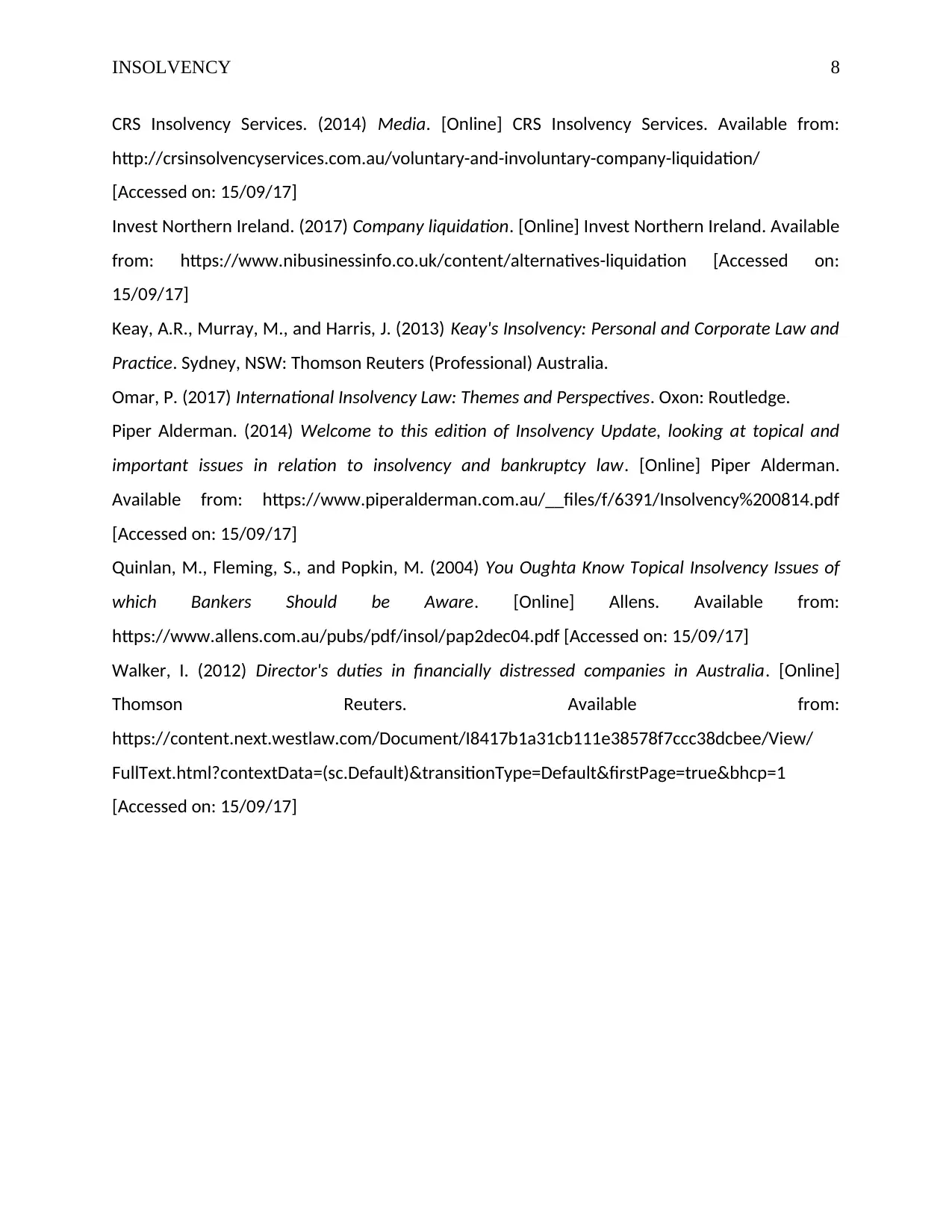
INSOLVENCY 8
CRS Insolvency Services. (2014) Media. [Online] CRS Insolvency Services. Available from:
http://crsinsolvencyservices.com.au/voluntary-and-involuntary-company-liquidation/
[Accessed on: 15/09/17]
Invest Northern Ireland. (2017) Company liquidation. [Online] Invest Northern Ireland. Available
from: https://www.nibusinessinfo.co.uk/content/alternatives-liquidation [Accessed on:
15/09/17]
Keay, A.R., Murray, M., and Harris, J. (2013) Keay's Insolvency: Personal and Corporate Law and
Practice. Sydney, NSW: Thomson Reuters (Professional) Australia.
Omar, P. (2017) International Insolvency Law: Themes and Perspectives. Oxon: Routledge.
Piper Alderman. (2014) Welcome to this edition of Insolvency Update, looking at topical and
important issues in relation to insolvency and bankruptcy law. [Online] Piper Alderman.
Available from: https://www.piperalderman.com.au/__files/f/6391/Insolvency%200814.pdf
[Accessed on: 15/09/17]
Quinlan, M., Fleming, S., and Popkin, M. (2004) You Oughta Know Topical Insolvency Issues of
which Bankers Should be Aware. [Online] Allens. Available from:
https://www.allens.com.au/pubs/pdf/insol/pap2dec04.pdf [Accessed on: 15/09/17]
Walker, I. (2012) Director's duties in financially distressed companies in Australia. [Online]
Thomson Reuters. Available from:
https://content.next.westlaw.com/Document/I8417b1a31cb111e38578f7ccc38dcbee/View/
FullText.html?contextData=(sc.Default)&transitionType=Default&firstPage=true&bhcp=1
[Accessed on: 15/09/17]
CRS Insolvency Services. (2014) Media. [Online] CRS Insolvency Services. Available from:
http://crsinsolvencyservices.com.au/voluntary-and-involuntary-company-liquidation/
[Accessed on: 15/09/17]
Invest Northern Ireland. (2017) Company liquidation. [Online] Invest Northern Ireland. Available
from: https://www.nibusinessinfo.co.uk/content/alternatives-liquidation [Accessed on:
15/09/17]
Keay, A.R., Murray, M., and Harris, J. (2013) Keay's Insolvency: Personal and Corporate Law and
Practice. Sydney, NSW: Thomson Reuters (Professional) Australia.
Omar, P. (2017) International Insolvency Law: Themes and Perspectives. Oxon: Routledge.
Piper Alderman. (2014) Welcome to this edition of Insolvency Update, looking at topical and
important issues in relation to insolvency and bankruptcy law. [Online] Piper Alderman.
Available from: https://www.piperalderman.com.au/__files/f/6391/Insolvency%200814.pdf
[Accessed on: 15/09/17]
Quinlan, M., Fleming, S., and Popkin, M. (2004) You Oughta Know Topical Insolvency Issues of
which Bankers Should be Aware. [Online] Allens. Available from:
https://www.allens.com.au/pubs/pdf/insol/pap2dec04.pdf [Accessed on: 15/09/17]
Walker, I. (2012) Director's duties in financially distressed companies in Australia. [Online]
Thomson Reuters. Available from:
https://content.next.westlaw.com/Document/I8417b1a31cb111e38578f7ccc38dcbee/View/
FullText.html?contextData=(sc.Default)&transitionType=Default&firstPage=true&bhcp=1
[Accessed on: 15/09/17]
1 out of 8
Related Documents
Your All-in-One AI-Powered Toolkit for Academic Success.
+13062052269
info@desklib.com
Available 24*7 on WhatsApp / Email
![[object Object]](/_next/static/media/star-bottom.7253800d.svg)
Unlock your academic potential
Copyright © 2020–2025 A2Z Services. All Rights Reserved. Developed and managed by ZUCOL.





